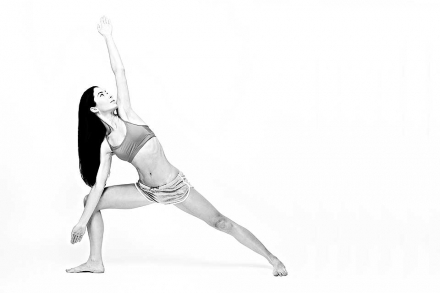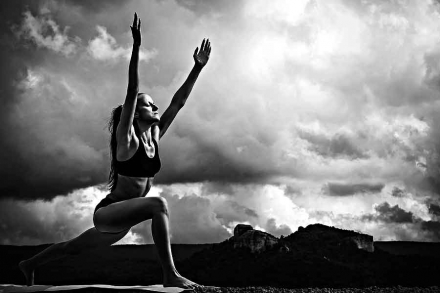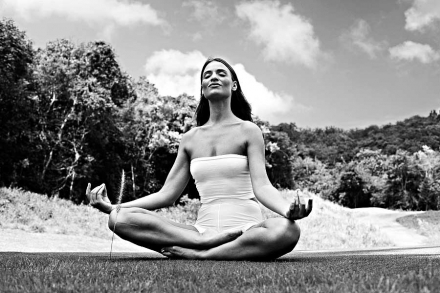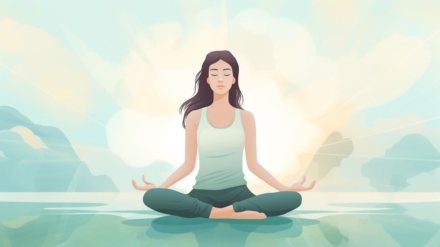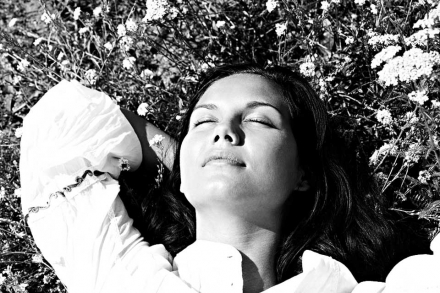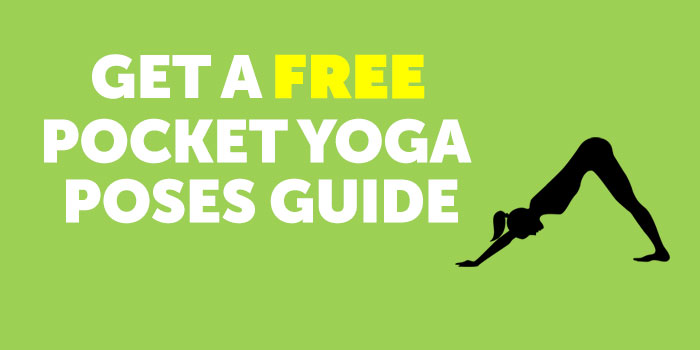Welcome, yoga newbie! We’re thrilled you’ve decided to dip your toes (and maybe even do a downward dog) in the wonderful world of yoga. This article is the ultimate beginner yoga guide, designed to help you navigate your way from “Yoga, who?” to “Yoga guru” in no time. If you’ve been asking yourself “How do I start yoga?”, then you’re in the right place. We’ll get you started on your journey, breaking down everything you need to know about starting yoga in a way that won’t leave you scratching your head.
We know that starting anything new can be a bit daunting, but don’t worry, we’re here to help make this process as smooth as a Warrior II pose. Our comprehensive guide to Yoga for beginners is packed full of practical advice, handy tips, and a sprinkle of light humor to keep things fun and engaging. It’s like getting advice from a friend who’s been there, done that, and is excited to share the journey with you. So, unroll your mat and get ready to become a certified yogi!
Understand the Basics of Yoga for Beginners
Let’s Understand the Basics of yoga together! First, we’ll explore the Different Types of Yoga, offering a variety of yoga styles to suit everyone. Next, we delve into the myriad Benefits of Practicing Yoga, which will surely motivate you. It’s important to remember Safety Guidelines for Beginners to ensure a smooth journey. Understanding Yoga Breathing Techniques is a key part of the practice, enhancing your overall experience. Lastly, we’ll outline a typical Yoga Sessions Structure, to give you an idea of what to expect. Let’s embark on this exciting yoga journey together.
Different Types of Yoga
Transitioning smoothly from our introduction, let’s dive into the marvelous world of yoga. To start our journey, we’ll explore the Different Types of Yoga.
Isn’t it wonderful how versatile yoga is? It offers various types that cater to different needs and preferences, making it a truly universal practice. You might have heard of Hatha Yoga, which is ideal for beginners due to its slower pace. For those seeking relaxation and mindfulness, Restorative Yoga could be your best pick. Want to break a sweat? Try the challenging Ashtanga Yoga or Power Yoga.
If you’re drawn to spirituality, you might find Kundalini Yoga intriguing. For a more modern, fitness-oriented approach, Vinyasa Flow could be your perfect match. Isn’t it exciting to choose your path according to what suits you best? Remember, the beauty of yoga lies in its diversity and flexibility! So, what type of yoga tickles your fancy?
Benefits of Practicing Yoga
Having explored the different types of yoga, let’s now dive into a sea of serenity and bask in the sunlight of wellness by exploring the benefits of practicing yoga.
Yoga, my friend, is like a magical potion that rejuvenates the body, calms the mind, and nourishes the soul. It’s a holistic health regimen that offers a wide array of benefits. On a physical level, it enhances flexibility, strength, and balance. Your body becomes a well-tuned instrument, capable of hitting the high notes of life with ease.
But wait, there’s more! The benefits aren’t just physical. Yoga is a stress-buster that promotes mental wellbeing. It soothes the mind, enhances focus, and fosters a sense of inner peace.
Above all, yoga is a journey of self-discovery and self-improvement. By practicing regularly, you’re not just doing a workout, you’re inviting positivity and wellness into your life.
Safety Guidelines for Beginners
As we glide from the basic understanding of yoga, let’s now delve into the crucial part of your yoga journey – the safety guidelines for beginners.
Yoga is a powerful tool to harmonize your mind and body, but it’s also a practice that requires mindfulness. Whether you’re practicing at home or in a studio, always prioritize your safety. Start by choosing a comfortable and quiet space that helps you focus.
Choose a flat surface to avoid imbalance during postures, and use a good quality yoga mat to prevent slipping. Don’t rush! Remember, every yogi was once a beginner, and it’s okay if you can’t achieve a pose at your first try. Listen to your body and respect its limits. Avoid overstretching and if you feel any discomfort, stop immediately.
Lastly, always warm up before starting your yoga routine. It helps in preparing your muscles and joints for the yoga poses. Just remember, yoga is not a competition – it’s a journey of self-discovery and self-love.
Choose the Right Equipment
Navigating the world of yoga equipment can be tricky, but we’ll guide you through it! Starting with yoga mats, the foundation of your practice, we’ll then explore the uses of blocks and straps. In the accessories and props section, you’ll discover items that can enhance your yoga experience. Choosing the right yoga straps can greatly impact your stretching and flexibility, so we’ll dive into that too. Lastly, we’ll list some essential yoga accessories, making sure you’re fully equipped for your yoga journey. So, let’s start choosing the right equipment together!
Yoga Mats
Let’s begin with the foundation of your yoga practice, the yoga mat.
A yoga mat is more than just a simple piece of equipment. It’s your sacred space, the place where you connect your mind, body, and spirit. It’s crucial to find a mat that suits your personal needs and preferences. There are different types of mats available, like thick mats for extra cushioning, thin travel mats for portability, or eco-friendly mats for those who are environmentally conscious.
It’s essential to choose a mat with the right amount of grip to prevent slipping during your practice. Also, consider the thickness and material of the mat. A thicker mat can provide more comfort, especially for sensitive joints, while the material can affect the mat’s texture, stickiness, sponginess, and eco-friendliness.
Stay tuned for the next section on Blocks and Straps. Enjoy your yoga journey!
Blocks and Straps
Talking about Blocks and Straps, these are your best friends when it comes to deepening your practice. Yoga blocks are the perfect assistant in adding extension to your poses and making those hard-to-reach asanas more accessible. They come in a variety of materials, from cork to foam, so you can choose what feels best for you!
On the other hand, yoga straps are like that supportive friend who always has your back. They provide the extra reach when you’re just a fingertip away from touching your toes or help you maintain alignment in poses where you’re still building flexibility.
Remember, these tools are here to support your journey, not to make it harder. So, don’t be shy about using them! They’re here to make your journey smoother and more enjoyable.
Accessories and Props
Elevating from the foundational knowledge of yoga, let’s now delve into the world of Accessories and Props that can bring more ease and comfort to your practice. These handy little helpers can make your yoga journey more enjoyable and effective.
The world of yoga props is vast and varied. From simple blocks to help with alignment, to bolsters for added support, these accessories can help you delve deeper into your practice. They not only support your body in various postures but also help in enhancing your flexibility, balance, and stability.
Remember, these aren’t just for beginners; even seasoned yogis use props to deepen their practice and learn new poses. So, don’t shy away from experimenting with different props to see what works best for you.
The right accessories and props can make a real difference in your yoga experience. So, it’s worth investing some time in understanding what they are and how they can benefit your practice. Enjoy exploring this exciting side of yoga!
Find the Right Yoga Class
When finding the right yoga class, consider various formats. In-person classes offer a community feel while online classes provide flexibility. For personalized guidance, consider private instruction. Also, always consider the class difficulty level to match your skills and goals. Lastly, trying a trial class can give you a firsthand experience before committing.
In-Person Classes
With your new yoga mat and gear in hand, excitement bubbles within you as you start your journey towards body and mind harmony. Now, let’s dive into In-Person Classes.
Attending in-person classes can be a magical experience. You get the opportunity to learn and grow in a supportive community that shares your passion. By joining a class, you don’t just learn the yoga poses, but also the correct posture and alignment. It can be an immense help, especially if you are a beginner.
Moreover, the direct feedback you receive from the instructor is invaluable. It helps you improve your practice and avoid potential injuries. Also, the shared energy in the room can be quite uplifting. Remember, the aim is not to execute a perfect pose, but to understand and listen to your body. Choose a class that makes you feel comfortable and excited, rather than intimidated. Your yoga journey is uniquely yours, so embrace it with an open heart and mind.
Online Classes
Having the right gear is a significant step, but your yoga journey doesn’t stop there. Now, let’s dive into finding the best yoga class that suits your needs.
In this digital age, online classes are a popular and convenient choice. They offer the comfort of practicing yoga right at your home, with no concern about commute or fitting into your packed schedule. Online yoga classes, from beginner to advanced levels, are available at your fingertips.
Many platforms offer live-streamed classes, allowing you to interact with the instructor in real-time, while pre-recorded sessions give you the freedom to practice at your own pace. It’s crucial to ensure that these classes are conducted by certified instructors.
Remember, the beauty of online classes lies in their flexibility. So, choose a platform that aligns with your schedule, comfort, and learning speed. Stay tuned for more about private instructions, class difficulty levels, and trial classes!
Private Instructions
Now that you’ve got your yoga equipment picked out, it’s time to find a class that suits your needs. Let’s talk about Private Instructions.
Private yoga classes are a fantastic way to get started with yoga or deepen your practice. With private instructions, you get the luxury of one-on-one attention from a certified yoga instructor. This personalized approach can be beneficial if you have specific health concerns, injuries, or goals.
Having a private instructor means the class moves at your pace. You can work on perfecting your form and learning new techniques in a comfortable, stress-free environment. Plus, you can schedule sessions to fit your busy lifestyle.
Don’t forget, though, private instructions are generally more costly than group classes. So, it’s a good idea to weigh the benefits against your budget. As a beginner, you might find it helpful to try a mix of group classes and private sessions. You never know, private instructions might just be the perfect fit for you!
Learn the Basic Poses
Let’s start with Mountain Pose, a perfect foundation for all standing postures. Next is the Tree Pose, which enhances your balance and concentration. The Downward Dog is another fundamental pose, stretching and strengthening your whole body. Now, let’s challenge ourselves a bit more with Practicing Warrior Poses, fostering strength and stamina. Lastly, we have Knowing Child’s Pose, a comforting resting position that promotes relaxation.
Mountain Pose
Having found the right yoga class for your needs, it’s time to familiarize yourself with some basic poses that will help you feel more comfortable and confident on your yoga mat. Let’s begin with the Mountain Pose, a foundation for all standing poses in yoga.
The Mountain Pose, also known as Tadasana, is all about grounding yourself. It’s quite simple but equally powerful. Stand with your feet hip-width apart, distribute your weight evenly, and let your arms hang naturally by your sides. Try to maintain a straight posture, elongate your spine, and tuck your pelvis slightly under. Hold this pose for a few deep breaths, feeling the earth beneath your feet and the sky above your head.
This pose is perfect for beginners. It helps improve posture, balance, and calm focus. Remember, every yoga journey starts with a single pose, and the Mountain Pose is a great place to begin!
Tree Pose
Now that you’re all set with finding the right class, let’s dive into the heart of yoga – the poses. One of the most beautiful and serene yoga asanas is the Tree Pose or Vrksasana. This pose might seem simple, but it’s packed with numerous benefits.
To do the Tree Pose, start by standing straight. Slowly shift your weight to your left leg, and bend your right knee. Place the sole of your right foot on your left inner thigh. Once you’re balanced, bring your hands together in front of your chest in a prayer position. If you’re feeling sturdy, you can raise your arms above your head. Keep your gaze forward and hold the pose for a few breaths.
Remember, it’s okay if you wobble or can’t get your foot very high. The important part is trying. The more you practice, the better you’ll get! The Tree Pose is all about balance and calm – just like a tree swaying gently in the wind.
Downward Dog
Now that you’ve found the right yoga class, let’s dive right into learning some basic poses! Our next stop on this yoga journey is one you’ve likely heard of: the Downward Dog.
A staple in most yoga practices, the Downward Dog is a pose that helps to rejuvenate and energize the body. It’s a fantastic way to stretch your entire body, particularly the hamstrings, shoulders, and calves. It can also help improve digestion, relieve back pain, and calm the mind.
To perform this pose, start on your hands and knees. Then, lift your hips towards the ceiling, straightening your legs and arms, and forming an upside-down V shape with your body. Remember to keep your hands shoulder-width apart and feet hip-width apart. Don’t worry if your heels don’t touch the ground – that comes with practice.
Take a few deep breaths in this pose and embrace the stretch. Happy practicing!
Incorporate Breath Work
Incorporating Breath Work can transform your daily routine. Starting with Ujjayi Breath, you’ll learn how to control your breath, leading to tranquility. Moving onto Nadi Shodhana Pranayama, you’ll discover balance, as it cleanses your energy channels. Kapalabhati Pranayama will increase your vitality, by providing a cleansing effect. We’ll also explore Breath Work for Relaxation, helping you unwind after a long day. Lastly, we’ll dive into the numerous Benefits of Breath Work, which ranges from stress reduction to improved concentration.
Ujjayi Breath
While mastering basic poses is an essential foundation in your yoga journey, incorporating breath work can greatly enrich your practice. Now, let’s dive into the first breath technique, the Ujjayi Breath, often referred to as the “Victorious Breath”.
The Ujjayi Breath is a diaphragmatic breath, which first fills the lower belly, rises to the lower rib cage, and finally moves into the upper chest and throat. To perform this, slightly constrict the back of your throat, and breathe through your nose. This should result in a soothing sound, similar to the ocean waves.
Practicing Ujjayi allows you to stay grounded and focused. It helps in maintaining a steady rhythm during your yoga practice and increases your capacity to hold a pose longer. Not only that, but it also warms up the body, making it an excellent breath technique to use at the start of your yoga practice. Remember, yoga is not just about the poses, but also the harmony between the breath and movement.
Nadi Shodhana Pranayama
Moving beyond the realm of poses, let’s venture into the invigorating world of breath work. One such practice that stands out is the Nadi Shodhana Pranayama, also known as alternate nostril breathing.
This technique is quite simple and very relaxing. You start by sitting comfortably with your spine erect and shoulders relaxed. Close your right nostril with your right thumb and inhale slowly through the left nostril. Then close the left nostril with your ring finger, release your thumb, and exhale through your right nostril. Repeat this process, inhaling through the right nostril this time.
This is a great breath work practice to calm your mind, improve focus, and reduce stress. Plus, it’s a fantastic way to balance both halves of your brain. Remember, Nadi Shodhana Pranayama isn’t just about the act of breathing, it’s about feeling the breath and the magical balance it brings.
Kapalabhati Pranayama
Now that you’ve gotten a feel for the basic yoga poses, let’s add another layer to your practice: breath work. Specifically, let’s dive into the invigorating practice of Kapalabhati Pranayama.
Also known as the “Breath of Fire”, Kapalabhati Pranayama is a powerful breathing technique that brings energy and heat to the body. It’s an active exhale followed by a passive inhale, done quickly and rhythmically. To practice, sit comfortably and take a deep breath in. Then, forcefully expel the air from your lungs by contracting your diaphragm, followed by a natural inhale. Repeat this for a series of 10-20 breaths.
Not only does this breath work boost your energy, but it also aids in detoxification and improves digestion. Remember to always listen to your body and take it easy if you need to. Breath work is a wonderful addition to your yoga practice, enhancing both its physical and mental benefits.
Create a Yoga Routine
Creating a yoga routine is a proactive step towards a healthier lifestyle. First, it’s key to set a schedule that works for you, ensuring consistency. Next, it’s time to choose appropriate poses that match your fitness level and goals. Remember that yoga isn’t a one-size-fits-all exercise, so feel free to modify poses as needed. It’s important to listen to your body and adjust accordingly. Once you have your poses, scheduling your routine will keep you organized. Finally, always revisit your choices, making sure you’re selecting suitable yoga poses that align with your progress and objectives.
Set a Schedule
Now that you’ve learned how to incorporate breath work into your yoga practice, let’s take it a step further. The next phase in creating your yoga routine is to Set a Schedule. 😊
Setting a schedule is crucial to maintain consistency and truly benefit from yoga. Take out a few minutes from your busy day, and dedicate them solely to your well-being. Whether you’re an early bird who loves to start your day with a yoga session or a night owl who prefers to wind down with some calming poses, choose a time that works best for you. Remember, consistency is key.
Try to stick to your schedule as much as possible. It may be challenging initially, but once you get into the groove, it will become a part of your daily routine. Remember, your commitment determines your success. So, set a schedule and stick to it!
Choose Appropriate Poses
As you find your breath flowing more freely and your body warming up to the rhythm of your deep inhales and exhales, it’s time to take the next step on your yoga journey. Let’s chat about how you can Choose Appropriate Poses for your routine.
Firstly, it’s crucial to remember that yoga is a personal journey. Each pose has a different impact on the body and mind, so it’s important to select poses that align with your specific needs and goals. For instance, if you aim to strengthen your core, poses like Plank and Boat Pose are great choices.
Also, pay attention to your body’s signals. If a certain pose causes discomfort or strain, it might not be the right fit for you. Try to find alternatives that provide similar benefits without causing discomfort.
Remember, each yoga session is a celebration of what your body can do, not a competition. So, choose poses that make you feel strong, balanced, and at peace. Happy posing!
Modify Poses as Needed
Just as you’ve been learning to tune into your breath, it’s equally important to listen to your body when you’re practicing yoga poses. This leads us to the third part of our yoga routine creation: Modify Poses as Needed.
Let’s face it, we’re all unique and so are our bodies. The flexibility and strength vary from person to person. So, it’s perfectly okay if you cannot perfect a pose in the first go or even after several sessions. The key is to be patient and persistent.
Remember, yoga is not about pushing your body to its limits, but rather about finding a balance between strength and ease. If a pose is causing discomfort, feel free to modify it according to your body’s needs. Don’t hesitate to use props like blocks or straps to make the pose more accessible.
Most importantly, listen to your body and respect what it’s telling you. After all, yoga is about unity and harmony, not just with your breath, but with your whole self as well.
Make Time for Meditation
Discover the Benefits of Meditation, a practice that can improve mental clarity and emotional well-being. Explore the Different Types of Meditation to find one suited to your needs. Creating a Meditation Routine can make this practice a regular part of your day. Incorporating Meditation into Yoga Practice harmonizes mind and body. Lastly, we’ll explore how to maintain Mindfulness during Meditation. Make time for meditation, it’s worth it!
Benefits of Meditation
As we journey further down the path of holistic wellness, let’s pivot from the physicality of yoga to the tranquility of meditation. Meditation, a complement to yoga, has a plethora of benefits that should not be overlooked.
Engaging in regular meditation can lead to increased concentration, reduction in stress, and enhanced self-awareness. A significant benefit is its capacity to reduce stress. It helps in decreasing the cortisol levels, a stress hormone, in our body. This reduction in cortisol can improve your sleep, lower blood pressure, and foster a sense of inner peace.
Moreover, meditation promotes emotional well-being. It allows you to gain a new perspective on challenging situations, increasing self-awareness and focusing on the present. This practice can even lead to improvements in physical health, such as reducing age-related memory loss and increasing stamina and endurance.
Lastly, meditation helps to generate kindness. It enables you to develop a more positive outlook towards yourself and others.
Different Types of Meditation
Breathing deeply from our yoga routine, let’s now dive into the serene ocean of meditation. Different types of meditation can offer us various benefits and experiences. The loving-kindness meditation promotes positivity, empathy, and compassionate behavior towards others, while the mindfulness meditation helps us to focus on living in the present moment without judgment. For those who seek spiritual growth, transcendental meditation is an excellent choice, as it involves repeating a mantra in a specific way to settle your mind.
If visualization relaxes you, you might enjoy guided visualization meditation, where you create a peaceful place in your mind. Then there’s progressive relaxation, also known as body scan meditation, perfect for those who need help falling asleep. Remember, there’s no one-size-fits-all in meditation. Explore and find what resonates with you. Embrace the journey, and remember, every step is a step towards a calmer, more centered you.
Creating a Meditation Routine
Transitioning from yoga, it’s time to delve into the calming world of meditation. Now that you are relaxed and open, let’s dive into Creating a Meditation Routine.
Firstly, choose a dedicated time that suits your schedule. Consistency is key, as it helps meditation become a habit. Ideally, meditate early in the morning or before bedtime to cultivate calmness.
Secondly, designate a serene space for your practice. This could be an uncluttered corner of your room or a peaceful outdoor spot. It’s important that this space evokes tranquility.
Finally, start small. Try to meditate for just a few minutes each day, gradually increasing the time as your concentration improves. Remember, it’s not about the length of time you meditate, but the quality of your mindfulness during the process.
So, are you ready to embark on this journey of self-discovery and inner peace? Let’s do this together!
Practice Mindful Eating
To fully embrace the practice of Mindful Eating, we’ll delve into the benefits of this lifestyle. Next, let’s understand your unique Hunger Cues for better self-awareness. We’ll follow up with some practical Tips for Eating Mindfully, and explore some core Mindful Eating Practices. Lastly, we’ll equip you with some effective Tools for Mindful Eating, to help make your journey smoother. Let’s dive in, shall we?
Benefits of Mindful Eating
Just as meditation brings mindfulness to our thought process, let’s now discuss how we can bring the same level of awareness to our eating habits. Welcome to the world of Mindful Eating.
The benefits of mindful eating are manifold and extend beyond just weight control. First and foremost, it allows you to truly savor every bite, enhancing your enjoyment of food. It also helps you make healthier choices, thus improving your overall nutrition. Another significant perk is that it can help you identify emotional eating triggers and manage them better.
Moreover, studies show that conscious eating can reduce overeating and binge eating episodes. By paying attention to what and when you’re eating, you can avoid the mindless munching that often leads to weight gain.
In short, mindful eating can be a powerful tool to regain control over your diet and establish a healthier relationship with food. Isn’t that fantastic? Stay tuned as we delve deeper into identifying hunger cues and adopting mindful eating practices.
Identifying Your Hunger Cues
Just as meditation helps focus your mind, mindful eating can help focus your attention on the experience of eating. Now, let’s dive into one crucial aspect of mindful eating: Identifying Your Hunger Cues.
Understanding your hunger cues is like learning a new language – the language of your body. It’s important to recognize when you’re actually hungry versus when you’re just bored or stressed. A real hunger cue might be a growling stomach, low energy, or even irritability. On the other hand, emotional hunger often comes on suddenly and craves specific comfort foods.
Remember, it’s okay to eat when you’re truly hungry. Mindful eating is not about restricting food, but rather about understanding your body’s needs and responding in a healthy way. So, start tuning into your body’s signals and listen to your hunger cues. This will be the cornerstone of your mindful eating journey.
Tips for Eating Mindfully
As we delve deeper into mindfulness, we discover that it’s not just about meditation. The concept also applies splendidly to our daily eating habits. Let’s explore some Tips for Eating Mindfully.
Firstly, it’s essential to eat without distractions. So, turn off the TV and keep your phone away during meals. Secondly, don’t rush. Eating should not be a race. Enjoy every bite and appreciate the flavors. This allows your body and mind to register the food you’re eating.
Another tip is to focus on the quality of food rather than quantity. Opt for nutritious and wholesome meals over processed snacks. Lastly, remember to listen to your body’s hunger and fullness cues. Overeating or undereating will only cause discomfort and health issues.
Incorporating these tips into your routine will enhance your relationship with food and improve your overall well-being. Enjoy the process of mindful eating and discover the joy it brings.
Integrate Yoga into Your Life
To Integrate Yoga into Your Life, start by Making it a Habit. Regular practice is key, so set Realistic Goals to stay motivated. Always remember to Listen to Your Body; yoga is not about pushing your limits but about finding your balance. To further support your journey, Creating a Yoga Space at Home can offer a serene environment. Lastly, Scheduling Regular Yoga Sessions will keep you on track and ensure that yoga becomes a salient part of your routine.
Make it a Habit
Just as you’re learning to pay attention to your eating habits, it’s essential to bring a similar awareness to your yoga practice. Let’s now delve into how you can integrate yoga into your life. First off, Make it a Habit.
Creating and sticking to a routine is key in any new endeavor, and this holds true when integrating yoga into your life. Like brushing your teeth or having your breakfast, make yoga a regular part of your day. It doesn’t have to be a long session; even ten minutes of focused practice can make a difference.
Remember, consistency is more important than duration. So, aim to practice yoga at the same time each day, whether it’s first thing in the morning or right before bed. It might be challenging at first, but with time, this new habit will become as natural as breathing. Turning yoga into a daily habit not only helps in establishing a routine but also in experiencing its long-term benefits.
Set Realistic Goals
Just as mindful eating can transform your relationship with food, integrating yoga into your life can revolutionize your physical and mental health. Now, let’s discuss setting realistic goals for your yoga journey.
Yoga isn’t about perfecting a pose or competing with anyone. It’s your personal journey. So, when setting your yoga goals, keep them achievable and personal to you. Whether it’s to do a certain pose, to practice for a set amount of time each day, or to simply feel more relaxed and centered, make sure your goals resonate with you.
Remember, progress over perfection. You might not be able to touch your toes today, and that’s okay! Set a goal to maybe touch your knees, and slowly work your way down. This way, you’re setting yourself up for success rather than frustration. Remember, yoga is a practice, not a destination. Be patient, and enjoy the journey towards your goals!
Listen to Your Body
Just as mindful eating encourages you to tune into your body’s signals, yoga also emphasizes this essential practice. So let’s delve into the importance of listening to your body during yoga.
This is a cornerstone of any yoga practice. It’s about understanding your body’s needs, abilities, and limits. It’s not about pushing yourself to match the person on the next mat or a picture in a magazine. So, try not to compare your progress with others. Every body is unique and yoga is a personal journey.
When practicing yoga, pay attention to how different poses make you feel. If you feel any discomfort or pain, it’s your body’s way of telling you to ease up or modify the pose. Likewise, if a pose feels good and you want to hold it longer, go ahead. In yoga, it’s important to respect your body’s signals. Remember, yoga is not a competition, it’s a path to wellness and self-discovery.
Closing Meditation
Starting yoga can be a transformative journey. This beginner yoga guide has covered the basics, from choosing the right equipment to making time for meditation. Remember, yoga for beginners is about progress, not perfection.
Embrace the journey of starting yoga, and let it enhance every aspect of your life. With regular practice, patience, and mindfulness, the benefits will be substantial. So, keep practicing, keep learning, and most importantly, enjoy the experience. Welcome to the wonderful world of yoga.
0






